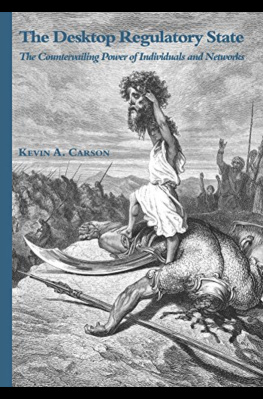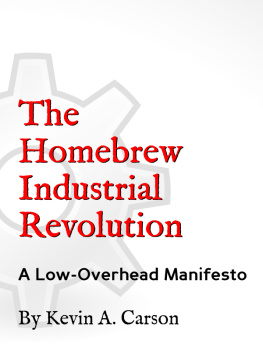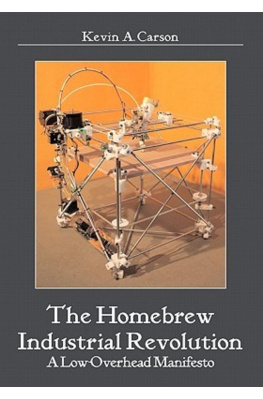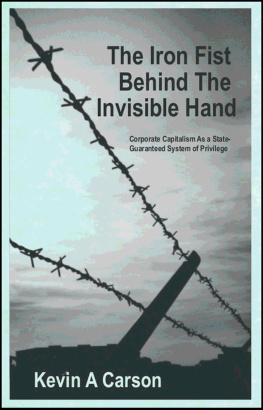Kevin A. Carson - The Desktop Regulatory State
Here you can read online Kevin A. Carson - The Desktop Regulatory State full text of the book (entire story) in english for free. Download pdf and epub, get meaning, cover and reviews about this ebook. year: 2016, genre: Politics. Description of the work, (preface) as well as reviews are available. Best literature library LitArk.com created for fans of good reading and offers a wide selection of genres:
Romance novel
Science fiction
Adventure
Detective
Science
History
Home and family
Prose
Art
Politics
Computer
Non-fiction
Religion
Business
Children
Humor
Choose a favorite category and find really read worthwhile books. Enjoy immersion in the world of imagination, feel the emotions of the characters or learn something new for yourself, make an fascinating discovery.
- Book:The Desktop Regulatory State
- Author:
- Genre:
- Year:2016
- Rating:4 / 5
- Favourites:Add to favourites
- Your mark:
- 80
- 1
- 2
- 3
- 4
- 5
The Desktop Regulatory State: summary, description and annotation
We offer to read an annotation, description, summary or preface (depends on what the author of the book "The Desktop Regulatory State" wrote himself). If you haven't found the necessary information about the book — write in the comments, we will try to find it.
The Desktop Regulatory State — read online for free the complete book (whole text) full work
Below is the text of the book, divided by pages. System saving the place of the last page read, allows you to conveniently read the book "The Desktop Regulatory State" online for free, without having to search again every time where you left off. Put a bookmark, and you can go to the page where you finished reading at any time.
Font size:
Interval:
Bookmark:
Like every book Ive written since the first, this book was inspired by ideas I encountered in researching the previous one but was unable to explore and develop as much as Id have liked within that framework. In writing the material on crisis tendencies of capitalism in Studies in Mutualist Political Economy, the writings by Paul Goodman and Ivan Illich on the hegemony of bureaucratic culture set a train of thought in motion that eventually lead to writing Organization Theory. Researching the chapter on decentralized manufacturing technology in Organization Theory led, in turn, to a stand-alone book on micro-manufacturing (Homebrew Industrial Revolution).
This book, in turn, is the development of ideas on network organization and stigmergy I touched on in Homebrew Industrial Revolution. It applies many of the same ideas in the realm of information that I developed earlier in regard to physical production in that book. It also ties in some of the ideas I discussed in the chapter on labor organization in Organization Theory, like open-mouth sabotage, but in much greater scope.
This book was a much longer time writing than any of my others, and because so much of its content involved ongoing current news I had much greater difficulty in either finding a cutoff point or setting parameters to filter out excessive detail. In the Appendix I wound up deleting a great deal of detail Id previously incorporated on the activities of the various networked social movements starting with the Arab Spring, and shifted instead to a greater relative focus on the general principles behind the wave of networked movements since the EZLN uprising in 1994. My judgments on the level of detail to preserve were necessarily somewhat arbitrary; whether the result is satisfactory is up to the reader to decide.
This book, in keeping with the spirit of the subject matter, is far more a product of stigmergic organization and the wisdom of crowds than anything Ive previously written. In an attempt to adhere to Eric Raymonds principle that many eyeballs make shallow bugs, I first posted the roughly eight-month-old draft online at http://desktopregulatorystate.wordpress.com, warts and all, in March 2011. At the time it was four chapters (which have since fissioned into twelve), consisting mostly of placeholder notes in many places and containing some sections entirely blank except for the title. Since then Ive automatically updated the online text whenever it was edited. I have benefited from many suggestions and tips from those following the progress of the book, including Steve Herricks wonderful job formatting the online word processor template for the online text, as well as all the information I get from email discussion lists (particularly the P2P Foundation, C4SS working group and Networked Labor lists), the leads from friends on Twitter, and the blogs and news sites I follow via RSS reader. And many thanks in particular to my friend Gary Chartier at La Sierra University, who has formatted this as well as two of my previous books for print!
Several parallel developments are driving a trend toward the growing obsolescence of large, highly capitalized, hierarchical organizations, and the ability of networked individuals with comparatively cheap capital equipment to perform the functions formerly performed by such organizations. They include the drastically reduced cost of capital goods required for informational and material production, as well as drastically reduced transaction costs of coordinating efforts between individuals.
For most of the past two hundred years, the trend has been toward increasing capital outlays for most forms of production. The cost of the basic capital equipment required for productionthe mass-production factory, the large printing press, the radio or TV stationwas the primary justification for the large organization. The economy was dominated by large, hierarchical organizations administering enormous masses of capital. And the astronomical cost of production machinery was also the main justification for the wage system: production machinery was so expensive that only the rich could afford it, and hire others to work it.
In recent decades weve seen a reversal of this trend: a shift back from expensive, specialized machinery to inexpensive, general-purpose tools. Although this is true of both material and immaterial productionas attested by the recent revolution in garage-scale CNC machine toolsit was true first and most dramatically in the immaterial sphere.
The desktop computer is the primary item of capital equipment required for entering a growing number of industries, like music, desktop publishing and software design. The desktop computer, supplemented by assorted packages of increasingly cheap printing or sound editing equipment, is capable of doing what previously required a minimum investment of hundreds of thousands of dollars. In the words of Yochai Benkler: declining price of computation, communication, and storage have, as a practical matter, placed the material means of information and cultural production in the hands of a significant fraction of the worlds populationon the order of a billion people around the globe.(Of course since that passage was written the proliferation of cheapening smartphones has probably expanded the latter figure to include over half the worlds population.)
The growing importance of human capital, and the implosion of capital outlays required to enter the market, have had revolutionary implications for production in the immaterial sphere. In the old days, the immense outlay for physical assets was the primary basis for the corporate hierarchys power, and in particular for its control over human capital and other intangible assets. In many information and culture industries, according to Benkler, the initial outlay for entering the market in the days of broadcast culture was in the hundreds of thousands of dollars or more.
Since the introduction of the mechanical press and the telegraph, followed by the phonograph, film, the high-powered radio transmitter, and through to the cable plant or satellite, the capital costs of fixing information and cultural goods in a transmission mediuma high-circulation newspaper, a record or movie, a radio or television programhave been high and increasing.
The broadcast era media, for instance, were typified by high-cost hubs and cheap, ubiquitous, reception-only systems at the end.... [P]roduction in the information and entertainment industries was restricted to those who could collect sufficient funds to set up a hub. In other words, as the saying went, freedom of the press was great so long as you could afford to own a press.
The networked information economy, in contrast, is distinguished by network architecture and the [low] cost of becoming a speaker.
The first element is the shift from a hub-and-spoke architecture with unidirectional links to the end points in the mass media, to distributed architecture with multidirectional connections among all nodes in the networked information environment. The second is the practical elimination of communications costs as a barrier to speaking across associational boundaries. Together, these characteristics have fundamentally altered the capacity of individuals, acting alone or with others, to be active participants in the public sphere as opposed to its passive readers, listeners, or viewers.
Today most people in the developed world, and in a rapidly growing share of the developing world, can afford to own a press.
In the old days, the owners of the hubsCBS News, the Associated Press, etc.decided what you could hear. Today you can set up a blog, or record a podcast, and anybody in the world who cares enough to go to your URL can look at it free of charge (and anyone who agrees with itor wants to tear it apartcan provide a hyperlink).
Font size:
Interval:
Bookmark:
Similar books «The Desktop Regulatory State»
Look at similar books to The Desktop Regulatory State. We have selected literature similar in name and meaning in the hope of providing readers with more options to find new, interesting, not yet read works.
Discussion, reviews of the book The Desktop Regulatory State and just readers' own opinions. Leave your comments, write what you think about the work, its meaning or the main characters. Specify what exactly you liked and what you didn't like, and why you think so.










![Kline Kevin E. - SQL in a nutshell: [a desktop quick reference ; covers MySQL, Oracle, PostgreSQL, and SQL server]](/uploads/posts/book/138111/thumbs/kline-kevin-e-sql-in-a-nutshell-a-desktop.jpg)
